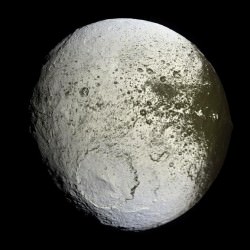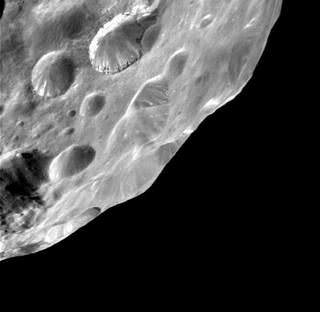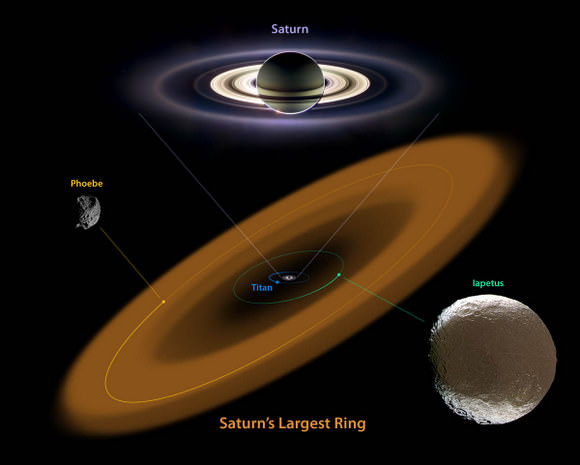[/caption]
The Spitzer Space Telescope has spied an enormous ring around Saturn, the largest and farthest distant band around this ringed world. Just how big is this ring? “If you had infrared eyes like Spitzer,” said Anne Verbiscer, research astronomer at the University of Virginia, Charlottesville, “from Earth, it would look like one full moon on either side of Saturn.” That’s incredibly huge! The bulk of its material starts about six million kilometers (3.7 million miles) away from the planet and extends outward roughly another 12 million kilometers (7.4 million miles). A billion Earths could fit in the volume of space this ring occupies.
So, why hasn’t this gigantic structure been detected previously?
“It is very, very faint; extremely tenuous,” Verbiscer told Universe Today. “If you were standing inside the ring you wouldn’t even know it. In a cubic kilometer of space there are only 10-20 particles. The particles are about the same size as fog particles, but they are very spread out. We’re just looking at the thermal emissions these little particles are giving off; we’re not looking at reflected sunlight at all in the observations we did with Spitzer. That’s what makes Spitzer the perfect instrument to use to try and find such a dust structure. This ring is completely analogous to debris disks around other stars that Spitzer has observed.”
The research team didn’t just stumble upon this ring; they were searching for it. The team includes Verbiscer, Douglas Hamilton of the University of Maryland, College Park, and Michael Skrutskie, of the University of Virginia, Charlottesville. They used the longer-wavelength infrared camera on Spitzer, called the multiband imaging photometer, and did their observations in February 2009 before Spitzer ran out of coolant in May and began its “warm” mission.

“For more than 300 years, people have been trying to explain the appearance of Saturn’s moon Iapetus, (which was discovered by Giovanni Cassini in 1671) and why one side of the moon is light and the other very dark,” said Verbiscer. “For the past 35 years, another moon, Phoebe has come up as a possible explanation, , as there is a connection between those two moons. Phoebe itself is very, very dark, and it matches the albedo or brightness of the dark material of Iapetus’ leading hemisphere. Phoebe has a retrograde orbit and Iapetus is in a pro-grade orbit. So if particles are launched off of Phoebe and spiral inward toward Saturn they would be smacking Iapetus right on that leading hemisphere.”
Verbiscer said that dynamically, this explanation for Iapetus’ dark side has been talked about and tried to be modeled. But no one had thought of using Spitzer to look for any dust in that area. “So, that was our idea,” she said. “The title of our proposal was ‘A New Saturnian Ring.’ We were definitely looking for a dust structure associated with Phoebe and in the same orbit, and that is precisely what we see.”
Verbiscer said it would be very difficult even for the Cassini spacecraft, and especially the imaging cameras to see this ring, since it shows up only in infrared. Plus Cassini is inside of this ring, and would have to look out past Saturn’s other rings. “This ring is so big but yet so faint, it would be difficult to know when you were looking at it and when you weren’t.”
The vertical height and orbital inclination of this ring matches perfectly with Phoebe’s orbit on the sky. “If you were to plot where Phoebe appears over time as it goes around Saturn, the ring matches exactly, Verbiscer said. “Think of a quarter spinning on a table; the ring has the same vertical tip to it, and Phoebe’s orbit does the same type of thing.”
As to whether the dust particles from Phoebe itself or if Phoebe “shepherding” some particles into that configuration, the scientists don’t have definite proof, but most likely the dust particles are from Phoebe. “We don’t have firm confirmation of that, but it is strongly suggestive that it comes from Phoebe,” Verbiscer said. “The materials all together amounts to what you would get from excavating a crater about a kilometer in diameter on Phoebe.”

Phoebe is 200 km across and heavily cratered, so a 1 km crater is not an overly huge crater. “So, we can’t look at a certain crater on Phoebe and say that one created the ring,” Verbiscer explained. “It’s likely it’s from several different smaller impacts, and ring keeps getting supplied from subsequent impacts and micrometeorites hitting Phoebe, launching material into this ring, putting dust and material from Phoebe’s surface into a Phoebe-like orbit.”
But there still is a bit of a mystery about the color of Iapetus’ leading hemisphere.
The two moons have frequently been compared in composition, and in near infrared, they share absorption features. In the ultraviolet, however, the spectra don’t match as well. “In terms of color, on Iapetus, the dark color looks a little more red compared to Phoebe, so there is a little color mismatch,” Verbiscer said. “It could be the particles launched from Phoebe mix with whatever is on Iapetus, which might account for the color difference. That might be something interesting to explore, to do some spectral mixing models to come up with some primordial Iapetus material and mix with Phoebe’s material see if they get reddened somehow.”
The ring itself is too faint to take a spectra to try and determine what materials make up the ring, but the assumptions are the materials come from the top surface of Pheobe’s cratered surface, which also might include some ice. Cassini close-ups of the moon from 2004 show bright craters, hinting that ice is close to the surface.
Spitzer was able to sense the glow of the cool dust, which is only about 80 Kelvin (minus 316 degrees Fahrenheit). Cool objects shine with infrared, or thermal radiation; for example, even a cup of ice cream is blazing with infrared light. “By focusing on the glow of the ring’s cool dust, Spitzer made it easy to find,” said Verbiscer.
The team’s paper appears in today’s issue of Nature. An online version is available here.
Lead image caption: Artist concept of the new Saturnian Ring. Credit: NASA/JPL-Caltech/R. Hurt (SSC) The inset credit (Saturn, Phoebe, and Iapetus) is NASA/JPL/SSI. Image courtesy Anne Verbiscer
Source: Interview with Anne Verbiscer


Major news! =8D
I went to Nature’s website and read the paper, there is a big discrepancy with the image here (and elsewhere):
the ring is not tilted, it is equatorial but thick (40+ Saturn radii), thanks to particle orbit precession, and Phoebe orbits inside it.
The original Spitzer images are displayed, no wonder all we see elsewhere is an artist’s work!
There is no evidence yet for the retrograde particle orbits.
And this: “Dynamical studies predict that small irregular saturnian satellites have struck Phoebe several times over the age of the Solar System14, providing known
historic sources of material, much of which remains in the ring today.” (I was wondering why only a small distant satellite would make such a ring).
On the funny side: this morning, AFP (Agence France Presse, through Google News) wrote it was a ring around Phoebe… Now corrected. The science editor was probably late today.
The Scientific American website reports that these observations were performed only three months before the coolant ran out on Spitzer’s 24micron MIPS camera. They mention that followup observations will require a new IR telescope to observe in the 24 micron band. Herschel, JWST anyone?
WRT material being transferred from Phoebe to parts of Iapetus, hasn’t the dark material on both moons been found to have similar spectra?
I do hope Herschel will take a look, but its shortest wavelength band being 55µ, I have no idea if it can actually see anything there.
from a purely scientific point of view… how absoblinkinglutely awesome!
What else dont we know?
Good work Spitzer !!!
Manu, what do you mean “the ring is not tilted”? Over on BBC Verbiscer says there’s a 27 degree tilt with respect to Saturn’s equatorial plane. (In the audio interview.)
Torbjorn:
As it is in the original NASA press release (I have a comment awaiting moderation with a couple of relevant links in it).
Well, I can’t access the Nature paper anymore, so I can’t check… I do remember reading that, but I might have had it wrong in the morning brain fog…
The ring was also observed at 70µ, so Herschel should be able to see it.
I’m sure we’ll find other rings like this around other planets, then decide to call them Dwarf Rings 😉
Would this ring, due to its faintness, be similar in composition to those around Jupiter, Uranus and Neptune? Another spectacular discovery!
I assume that if Phoebe is retrograde then it is a captured moon.
Do we know or guess what the dust is made of is it a basalt like the maria on our Moon?
Complaints:
1. How do I turn off google translate toolbar from UT?
2. Use Celsius instead of Kelvins.
Looks like big news.
Nasa version:
http://www.nasa.gov/mission_pages/spitzer/news/spitzer-20091006.html
@HeadAroundU: use Firefox? get NoScript add-on, and disable google.com. I did that, hate google intrusiveness. What business of theirs is my language?
haha I mentioned this news to UT!
————————————–
# sukye Says:
October 6th, 2009 at 8:38 pm
hey dont forget this news
http://www.spitzer.caltech.edu/Media/releases/ssc2009-19/release.shtml
————————————–
So this may account for the colour on Iapetus, anyone think it may have something to do with Iapetus’ “rindge?”